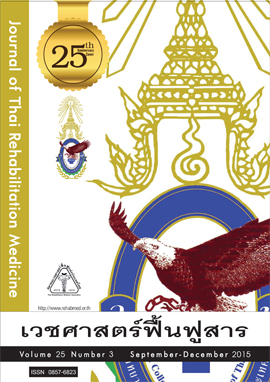ผลการปักเข็มกระตุ้นไฟฟ้าแบบฝังเข็มร่วมกับการทำแผลด้วย วิธีมาตรฐานต่อการสมานแผล: การศึกษานำร่อง
Keywords:
แผลกดทับ, แผลเรื้อรัง, การปักเข็มกระตุ้นไฟฟ้า, การสมานแผล, การฝังเข็ม, chronic wound, pressure ulcer, electrical stimulation, wound healing, acupunctureAbstract
Effect of Percutaneous Electrical Stimulation via Acupuncture Needle with Standard Wound Care on Wound Healing: a Pilot Study
Faithed C1, Wongviseskarn J2, Nithikornathiwat P3, Khunpasee A2
1Physical Medicine and Rehabilitation Department, Bhumibol Adulyadej Hospital,
2Physical Medicine and Rehabilitation Department, Phramongkutklao Hospital,
3Physical Medicine and Rehabilitation of Vibhavadi Hospital
Objective: To study effect of percutaneous electrical stimulation (ES) via acupuncture needle combined with a standard wound care on the wound healing in patients with chronic wounds or pressure ulcers.
Study design: Prospective, randomized, single-blinded, controlled trial study.
Setting: Physical Medicine and Rehabilitation Department, Phramongkutklao Hospital.
Subjects: Patients who had chronic wound or pressure ulcer at least stage II for more than 2 weeks.
Methods: Collected demographic data of all patients. Wound sizes (width, length and depth) were measured with sterile Vernia calipers, once a week for 1 month. All patients were treated with a standard wound care technique but the treatment (ES) group received additional percutaneous ES via an acupuncture needle 1cm from the wound edge. An electronic acupuncture instrument model SDZ II was used to provide a low voltage, monophasic pulse current. The level of intensity was adjusted until minimal muscle contractions without pain seen. Each session lasted 30 minutes, and the treatment group was treated 5 times a week for 4 weeks.
Results: There were 8 patients in the ES group and 7 in the control group. The wound size was reduced in width and length significantly after continuing treatment for 2 weeks and in depth in 4 weeks in both groups. The wound healing was more in the ES group than in the control group but not statistically significant (P>0.05). The percentage of average wound size reduction was 15.9% per week in the ES group and 9.6 % per week in control group respectively.
Conclusion: There was no difference in wound healing between the standard wound care and the combined percutaneous electrical stimulation and the standard wound care.
บทคัดย่อ
วัตถุประสงค์: เพื่อศึกษาผลการปักเข็มกระตุ้นไฟฟ้าแบบฝังเข็มร่วมกับการทำแผลด้วยวิธีการมาตรฐานต่อการสมานแผล
รูปแบบการทำวิจัย: การศึกษานำร่องเชิงทดลองแบบสุ่มปกปิด ทางเดียว
สถานที่ทำวิจัย: กองเวชศาสตร์ฟื้นฟู โรงพยาบาลพระมงกุฎเกล้า
กลุ่มประชากร: ผู้ป่วยที่มีแผลเรื้อรังหรือแผลกดทับที่มีความ รุนแรงระดับ 2 ขึ้นไป และเป็นมานานกว่า 2 สัปดาห์
วิธีการศีกษา: สำรวจข้อมูลเบื้องต้นเกี่ยวกับผู้ป่วย จับฉลาก แบ่งเป็น 2 กลุ่ม คือกลุ่มทดลอง 8 คน และกลุ่มควบคุม 7 คน ประเมินแผลลักษณะแผลทั่วไป และถ่ายภาพด้วยกล้องดิจิตอล วัดและบันทึกความกว้าง ความยาว ความลึก และการชอนของ แผล (undermining) ด้วย vernia caliper ที่ปราศจากเชื้อ และทำแผลด้วยวิธีมาตรฐานตามแนวปฏิบัติทางการพาบาลทั้ง 2 กลุ่ม กลุ่มทดลองได้รับการปักเข็มกระตุ้นไฟฟ้า ห่างจากแผล ไม่เกิน 1 ซม. และต่อกับเครื่องกระตุ้นไฟฟ้าสำหรับการฝังเข็ม (Electronic acupuncture treatment instrument รุ่น SDZ-II) โดยใช้คลื่นไฟฟ้าเป็นช่วง ๆ ที่มีความถี่ 100 เฮริซ์ท ใช้ความแรง สูงสุด 50 โวลท์ ปรับให้กล้ามเนื้อหดตัวเล็กน้อยนาน 30 นาที จำนวน 5 ครั้งต่อสัปดาห์ จนครบ 1 เดือน
ผลการศึกษา: พบว่า ขนาดแผลและลักษณะโดยทั่วไป เช่น กลิ่นและเนื้อตายเริ่มลด ลงหลังการรักษา 2 สัปดาห์ แต่ไม่แตกต่างระหว่างการศึกษา เชิงทดลองแบบสุ่มปิดฉลากทางเดียวกับกลุ่มควบคุมความ อย่างมีนัยสำคัญทางสถิติ (P >0.05) อย่างไรก็กลุ่มทดลองมี ขนาดแผลเล็กลง เท่ากับร้อยละ 15.9 ต่อสัปดาห์ เทียบกับกลุ่ม ควบคุม ร้อยละ 9.6 ต่อสัปดาห์ ตามลำดับ
สรุป: การปักเข็มกระตุ้นไฟฟ้าแบบฝังเข็มร่วมกับการทำแผล ด้วยวิธีมาตรฐาน ให้ผลการรักษาแผลกดทับไม่แตกต่างกับการ รักษาด้วยวิธีมาตรฐานเพียงอย่างเดียวอย่างมีนัยสำคัญทาง สถิติ






